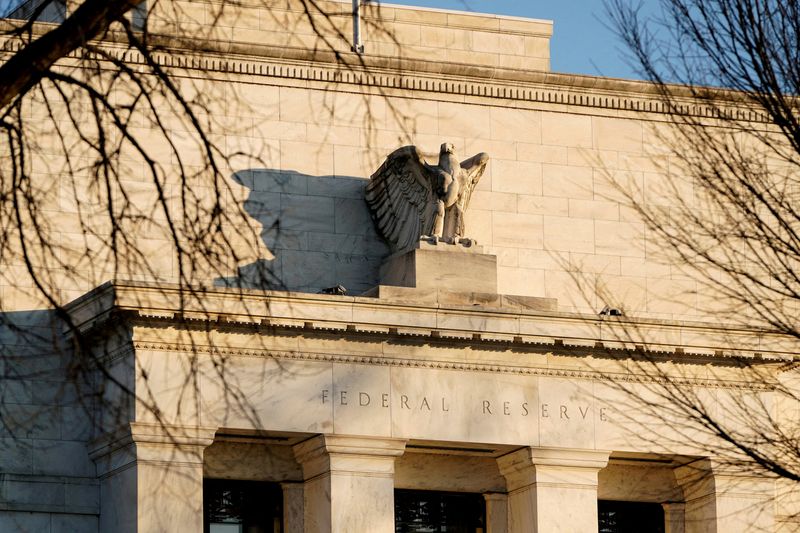By Gertrude Chavez-Dreyfuss
NEW YORK (Reuters) -Bond investors, expecting the Federal Reserve to cut interest rates by a quarter of a percentage point on Wednesday, are bracing for the central bank to scale back its easing in 2025 in anticipation of higher inflation under the Trump administration.
Market players are staying out of longer-dated Treasuries with U.S. inflation already looking stickier, preferring to hold notes on the front end to the middle of the curve, anywhere from two-year to five-year notes.
Fears of higher inflation typically prompt a selloff on the long end, pushing those yields higher as investors demand a premium to compensate for the risk of holding them.
The Fed is widely expected to lower its benchmark overnight rate by 25 basis points to the 4.25%-4.50% target range at the end of a two-day policy meeting that starts on Tuesday. But what it does after this week's meeting is an open question.
At least one bank - BNP Paribas (OTC:BNPQY) - sees the Fed holding rates steady all of next year and resuming its rate cuts again in mid-2026. Others see two or three quarter-percentage-point reductions in borrowing costs.
"A hawkish cut is consistent with both what the data will look like, but also potential policy changes from the new administration," said George Bory, chief investment strategist for fixed income at Allspring Global Investments.
"The Fed is trying to prepare the market for a deceleration in the pace of rate cuts and ... increase the optionality to be able to follow the data and be prepared to respond to policy changes."
Recent data depicted a resilient U.S. economy: a labor market that continues to create jobs and inflation that in November remained too hot for comfort. U.S. core consumer prices rose 0.3% for a fourth consecutive month in November, suggesting progress towards the Fed's 2% inflation goal has stalled.
Investors will also focus on Fed policymakers' quarterly economic projections, including rate forecasts, also known as the "dot plot," which reflects how much easing is expected. The "dots" from the September meeting, when the Fed kicked off its easing cycle with a 50-basis-point cut, showed a policy rate of 3.4% by the end of 2025.
The Fed hiked rates by 5.25 percentage points between March 2022 and July 2023, pushing the policy rate to the 5.25%-5.50% range, to fight an upsurge in inflation.
"The Fed will be less dovish in the summary of economic projections than they were during September, which is appropriate given the commentary that (Fed Chair Jerome) Powell made that the economy is stronger than he thought when they cut by 50 basis points," said Greg Wilensky, head of U.S. fixed income at Janus Henderson Investors, referring to the central bank's rate cut in September.
"I believe they will raise the 2025 dots by about 25 basis points from where it was," said Wilensky, who noted that his bond portfolios are currently overweight maturities below 10 years and underweight those 10 years and beyond.
NO-GO ON THE LONG END
Bond investors all year had been lengthening duration, or buying longer-dated assets, as they prepared for the Fed's easing and possible recession. As rates fall, bonds with higher yields become more attractive, causing their prices to rise.
Maturities of five to 10 years, for instance, are sensitive enough to capture price gains when rates drop, but they also carry less interest rate risk than longer-term bonds.
More recently, however, some investors have reduced duration, focusing on shorter-dated Treasuries instead, or stayed neutral.
"No one's really looking to aggressively extend duration right now," said Jay Barry, head of global rates strategy at J.P. Morgan. "That's a story about a more shallow easing cycle."
Going into this week's Fed meeting, asset managers cut net long positions on longer-dated assets such as Treasury bond futures, while leveraged funds increased net short positions on this maturity, Commodity Futures Trading Commission data showed.
Investors overall are staying away from the very long end of the curve, which is dependent on Treasury supply and longer-term inflation expectations, Allspring's Bory said.
Market participants expect a reacceleration of inflation with President-elect Donald Trump's incoming administration and its plan to cut taxes and impose tariffs on a range of imported products. These measures are likely to widen the fiscal deficit, pressure the long end of the curve, and elevate their yields.
"Tariffs are a potential inflation risk as they cause import prices to rise. They could end up as a one-time price shock or become an ongoing source of inflation," said Kathy Jones, chief fixed income strategist at Schwab.
BNP Paribas expects year-on-year U.S. CPI of 2.9% by the end of next year and 3.9% in 2026 due in part to tariffs. With higher inflation, the bank expects the Fed to remain on hold in 2025.

The Fed has already shown a "reticence to ease," said James Egelhof, BNP Paribas' chief U.S. economist, given the economy's resilience and growing concern that monetary policy may already be close to neutral.
"The Fed will not be able to simply look through a tariff-driven temporary pickup in inflation," he said.